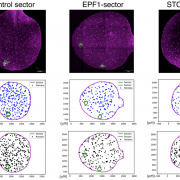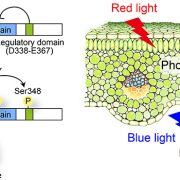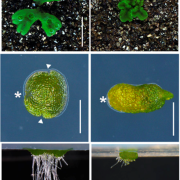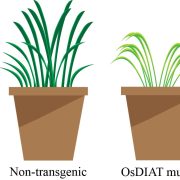Microtubule control during stomatal movement
Wang et al. investigate the function of SPR1 in ABA-induced stomatal closure
By Pan Wang and Sijia Qi
State Key Laboratory of Plant Physiology and Biochemistry; Department of Plant Sciences, College of Biological Sciences, China Agricultural University, Beijing 100193, China
Background: Drought is a major environmental problem worldwide. Stomata play important roles in plant adaptation to the environment. They are small pores surrounded by a pair of specialized guard cells on the surface of plant leaves and stems. Drought induces stomatal closure to avoid water loss. This process is tightly regulated by abscisic acid (ABA) signaling in guard cells, and is accompanied by the reorganization of the cytoskeleton. The cortical microtubules disassemble in response to ABA, which is essential for stomatal closure. However, how ABA signaling drives the change in microtubule organization in guard cells is unclear. Microtubules are regulated by multiple microtubule-associated proteins (MAPs); however, few MAPs related to stomatal closure have been characterized.
Question: We wanted to know whether and how specific MAPs respond to ABA signaling to regulate microtubule disassembly and stomatal closure. What is the direct link between MAPs and the core components in ABA signaling?
Findings: OPEN STOMATA 1 (OST1) is an important “switch” in ABA signaling. We found that OST1 mediated microtubule disassembly during ABA-induced stomatal closure in Arabidopsis. We identified a MAP SPIRAL1 (SPR1) as the substrate of OST1. When OST1 is activated by ABA, SPR1 can be phosphorylated by OST1 and facilitate microtubule disassembly. The spr1 mutant showed reduced microtubule disassembly and stomatal closure in response to ABA, resulting in greater water loss. These phenotypes were restored by introducing the phosphorylated form of SPR1. Our study demonstrates that SPR1 positively regulate microtubule disassembly in ABA-induced stomatal closure depending on OST1-mediated phosphorylation, and reveals a specific connection between a core component of ABA signaling and MAPs.
Next steps: In a future study, we will characterize more cytoskeleton binding proteins involved in ABA-induced stomatal closure. Furthermore, we will investigate how cytoskeleton dynamics affect other cellular structures or signaling molecules to regulate stomatal movement.
Pan Wang, Sijia Qi, Xiaohong Wang, Liru Dou, Meng-ao Jia, Tonglin Mao, Yushuang Guo, and Xiangfeng Wang. (2022). The OPEN STOMATA1-SPIRAL1 module regulates microtubule stability during abscisic acid-induced stomatal closure in Arabidopsis. https://doi.org/10.1093/plcell/koac307









